Oklahoma is a land of diversity; not only in its natural resources, but also in its opportunities for scientific exploration. That journey of exploration has been documented for the past century, in part, by the Oklahoma Academy of Science.
Created in 1909, when the state had 11 fledgling higher education institutions, the academy sought to bring the scientists of the state together for an exchange of ideas, and later to promote the scope and relevance of science to Oklahomans. Their mission became value added the following decade with the compilation of papers presented at the annual meetings, beginning in 1921.
Scientific Exchange: Then and Now
The inaugural “Proceedings of the Oklahoma Academy of Science” shared 37 papers, ranging from an interest in goats for the milk supply, to the stomach contents of three screech owls, to the linguistic creativeness of a child. Many of these early issues included simple observations made by members, leading to a history about Oklahoma that may not exist elsewhere. More recent collections still include a variety of scientific topics, but manuscripts are now peer-reviewed, often with requests for additional data and revisions, before acceptance into the publication.
Even before its first publication, the Oklahoma Academy of Science has fostered an exchange of knowledge of the state’s fish, wildlife and plant communities. Observations and research findings from naturalists, academic researchers, Wildlife Department biologists and many others have been shared at the annual meetings and through the proceedings. We’ve pored through the archives to find interesting observations and findings about our natural communities from the past 100 volumes.
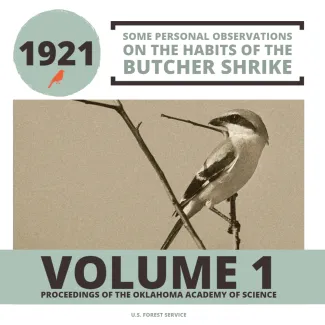
Oklahoma Geological Survey’s C.W. Shannon initially shared his 1916 observations on the habits of the butcher shrike, or loggerhead shrike, at an earlier annual meeting, but his notes were also shared in the very first “Proceedings of the Oklahoma Academy of Science.” Because this songbird relies on animal food for its chief subsistence, he noted “their life is one of continual warfare.”
In addition to documenting a shrike carrying a “cow blackbird” near Durant on Oct. 24, 1916 as it passed over the road and stopped in a nearby apple tree, Shannon also described watching a shrike impale a live grasshopper on a barbed wire fence. This tendency of impaling prey on thorns or barbed wire makes “quite an array of small birds, beetles, and other food, reminding one of a butcher’s rack filled with meats.”
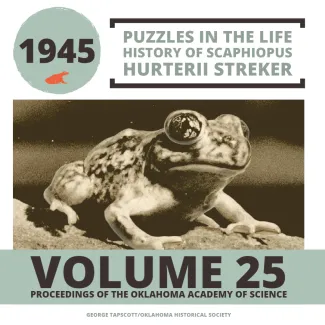
Spadefoot toads are curious species, emerging from their underground hideouts only a few months of the year to feed and mate. Oklahoma Biological Survey’s Arthur Bragg speculated on the reasons for this behavior, but admitted “no one knows which of these possibilities, if not some other, is the answer.” As scientists still do today, Bragg made a plea for others to help fill in the “Puzzles in the Life History of Scaphiopus Hurterii Streker.”
“I would much appreciate the receipt of specimens with data as full as possible … from any locality in Oklahoma or other regions.” Bragg’s interest in the Hurter’s spadefoot, then known as the savannah spadefoot, continued with at least three other notes in the “Proceedings of the Oklahoma Academy of Science” in 1946, 1949, and 1950.
Technology and information sharing have come a long way since 1945! You can help the modern-day Arthur Braggs of Oklahoma learn about Hurter’s spadefoots and other fish and wildlife by sharing photographs along with the “who, what, when and where” details of your sightings with the Wildlife Department or on platforms like iNaturalist, or eBird!
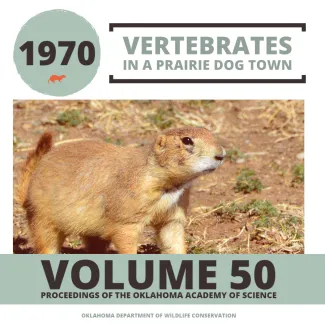
Prairie dog towns aren’t just for prairie dogs! To show the ecological importance of prairie dog towns, Cameron State College’s Jack Tyler documented the vertebrates at a town north and east of Duke during 15 visits.
Fifty-three vertebrate species were documented at the Duke prairie dog town between Aug. 1966 and Jan. 1970, including golden eagles, long-billed curlews, ground squirrels, collared lizards, and a barred tiger salamander. Tyler also noted the bodies of six Texas horned lizards at a hole occupied by a burrowing owl on his first visit in 1966. His highest species count of 23 vertebrate species, which included three amphibians, seven reptiles, seven birds and six mammals, occurred in May 1967.
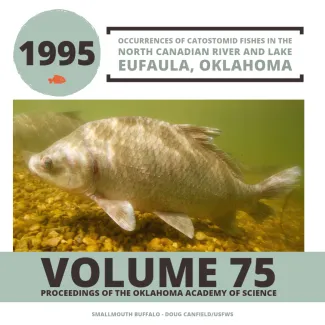
Jimmie Pigg, high school science teacher turned Oklahoma Department of Environmental Quality ichthyologist, authored or co-authored 42 articles in the “Proceedings of the Oklahoma Academy of Science,” including the results of a 17-year survey of the North Canadian River basin.
In that report, he paired data collected at 10 long-term sampling sites with more historic data to describe the distribution and abundance of catostomid fishes, or suckers. Seven sucker species were documented from the long-term sampling sites between 1976 and 1992, including 635 individual smallmouth buffalo. Two other species, the spotted sucker and golden redhorse, were added to the river basin’s sucker diversity from historic data. For each of the nine documented species, Pigg detailed the first known collection in the drainage, notes from past surveys, and a summary of his collections.
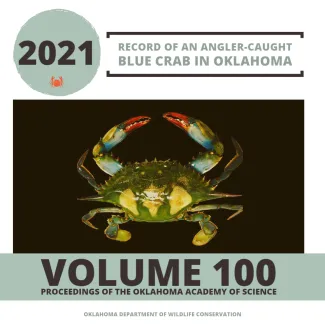
On July 7, 2020, a catfish angler reported catching a large blue crab in the tailwater below Overholser Reservoir in Oklahoma City. Biologists with the Wildlife Department collected the 0.4-pound crab and documented the record in the centennial volume of the “Proceedings of the Oklahoma Academy of Science.” Blue crab are native to the Atlantic and Gulf coasts and this female was a surprising find in an Oklahoma waterway.
As unique and unexpected as this 2020 record was, invasive species have become a relentless challenge that biologists face across the Nation. Non-native plants and animals can get their start in Oklahoma through a variety of intentional and accidental ways, and are difficult to eradicate once they gain a foothold. Their invasion can have dire consequences for our native communities and infrastructures. Oklahomans can help limit the spread of non-native plants and animals by cleaning, draining and drying watercraft; disposing of bait and unwanted pets properly; and reporting sightings to the Wildlife Department and Oklahoma Invasive Plant Council.
Want more historical fish and wildlife observations and findings? It was impossible to share the full impact of a century’s worth of fish and wildlife information sharing in one article. Browse the Oklahoma Academy of Science’s online catalog for an archive of our local science.